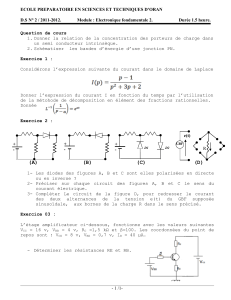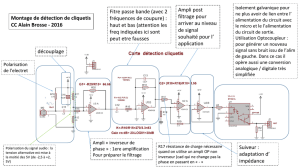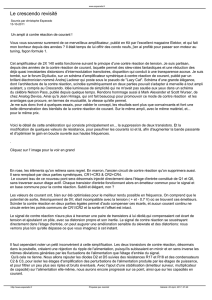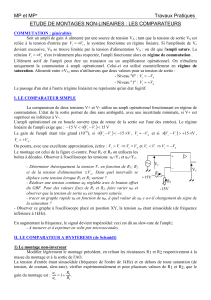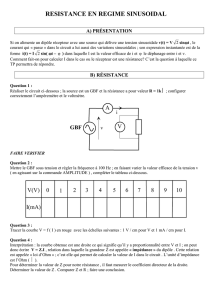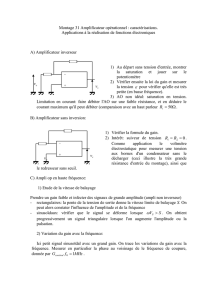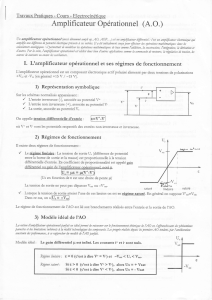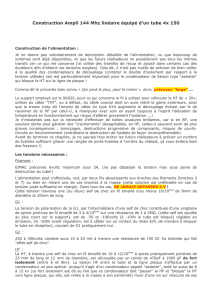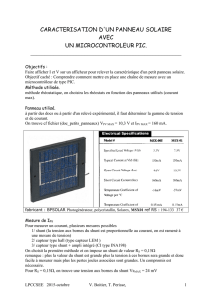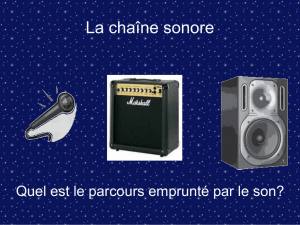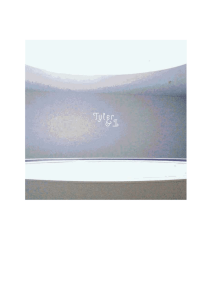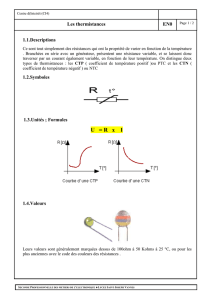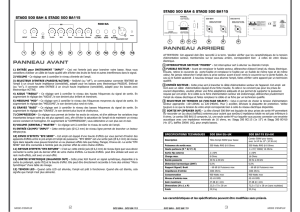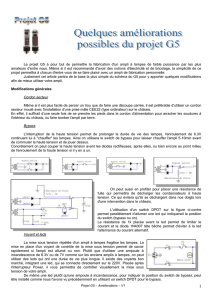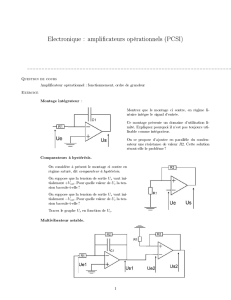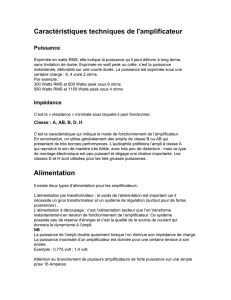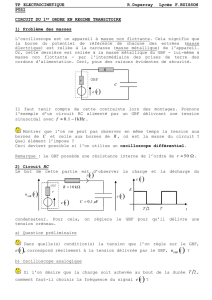Mesures et instrumentation Measurement and
publicité
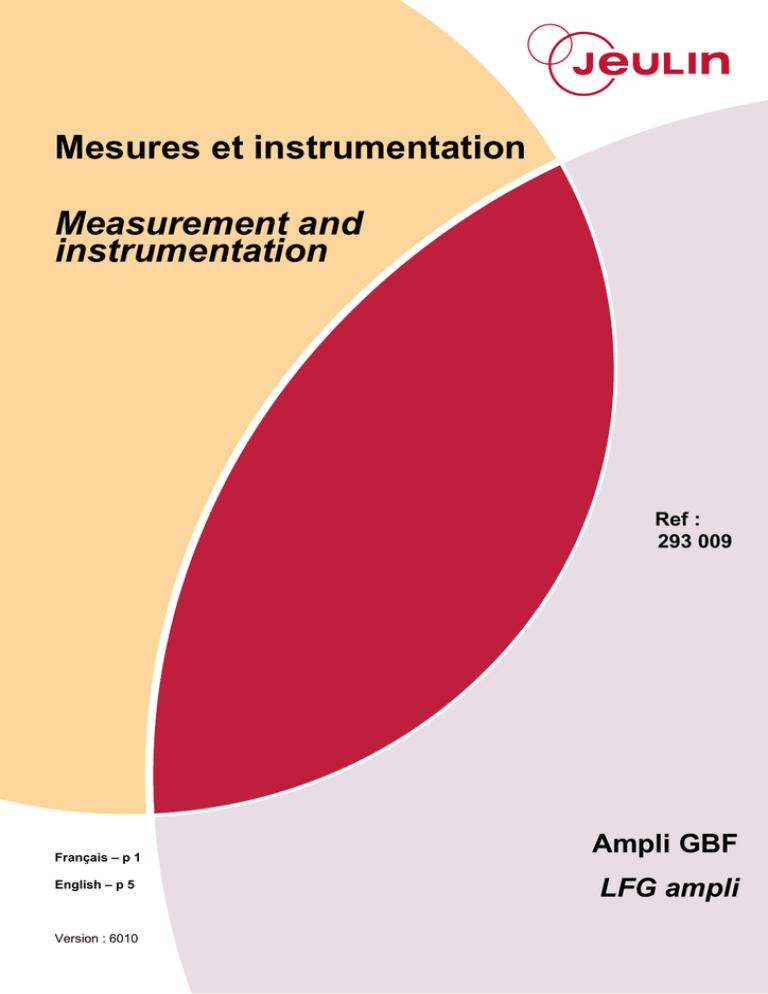
Mesures et instrumentation Measurement and instrumentation Ref : 293 009 Français – p 1 English – p 5 Version : 6010 Ampli GBF LFG ampli Mesures et instrumentation Ampli GBF Ref : 293 009 1 Description L’ampli GBF s’utilise en complément d’un générateur de fonctions non amplifié pour réaliser des manipulations nécessitant un courant de sortie important. L’appareil se connecte directement par des douilles de sécurité entre le générateur de fonctions et le circuit électrique. L’ampli GBF génère une amplification du signal de sortie jusqu’à 1 A efficace. Le courant délivré est proportionnel à la demande du circuit récepteur : la tension de sortie ne s’écroule pas en cas d’appel de courant jusqu’à 1 A. Schéma de branchement Ampli GBF Circuit récepteur GBF 2 Précautions d’emploi FRANÇAIS • Eviter de laisser l'ampli GBF fonctionner en plein soleil ou à proximité d'une source de chaleur importante. • N'obturer jamais fonctionnement. • Si cet appareil est utilisé d'une façon non spécifiée dans cette notice, la protection assurée par l'appareil peut être compromise. 1 les ouïes de ventilation pendant son Mesures et instrumentation Ampli GBF Ref : 293 009 Protection thermique L'amplificateur de puissance est protégé en température de fonctionnement par un système réarmable. Lorsque certaines conditions extrêmes d'utilisation sont réunies : tension secteur élevée (230V +10%) + signal de sortie à 10V crête, + température ambiante supérieure élevée, + charge comprise entre 0.8 et 1Aefficace, la sécurité de l'ampli GBF peut se déclencher après ½ heure d’utilisation. Dans ce cas, la sortie devient inactive. Il convient alors de couper l'appareil pendant au moins 1 heure avant de pouvoir le réutiliser. 3 Caractéristiques techniques • Amplification de signaux : sinusoïdal, triangulaire, carré • Bande passante : 0 à 20 kHz • Tension maxi d’entrée/sortie: 10 V crête • Gain en tension : 1 • Intensité de sortie maxi : 1 Aeff. • Impédance de sortie : 8Ω • Protections : Primaire : fusible calibré sur C.I. Secondaire : électronique par limitation d’intensité • Entrée / sortie : douilles de sécurité ∅ 4 mm • Alimentation : 230 V +/- 10%, 50-60 Hz • Puissance consommée sur secteur : 30 VA • Dimensions : 115 x 110 x 76 mm • Masse : 0.950 kg • Garantie : 2 ans Cet appareil est conforme à : - la directive Basse Tension 73/23/CEE ; norme appliquée : EN 61010-1 - la directive CEM 89/336/CEE ; normes appliquées : EN 50081-1 et EN50082-1 FRANÇAIS 2 Mesures et instrumentation Ampli GBF Ref : 293 009 Conditions d'environnement pour l'utilisation de l'appareil : • Utilisation en intérieur • Altitude inférieure à 2000 mètres • Température d'utilisation de 15°C à 40°C • Humidité relative maximale de 80% jusqu'à 31°C et 50% jusqu'à 40°C • Variations réseau de +/-10% • Catégorie d'installation II, degré de pollution 2 Sectionnement : C'est la fiche d'alimentation qui sert de dispositif de sectionnement Symboles utilisés : : Attention, voir documents d'accompagnement. : Attention, surface chaude. 4 Entretien et maintenance En cas de non-fonctionnement : • Vérifier la présence de la tension réseau (230 V) • Vérifier votre montage afin de détecter un éventuel court-circuit ou un débit de courant supérieur à 1 A. Dans tous les cas, ne pas ouvrir l'appareil. Le changement du fusible secteur doit être fait dans nos ateliers. Conserver l'emballage d'origine, il sera utilisé en cas de retour dans nos ateliers pour une éventuelle maintenance. 5 Exemples d’utilisation FRANÇAIS • Mesure de la position des nœuds et des ventres en fonction de la fréquence de vibration d’une corde (vibreur de Melde) • Etude de la vibration d’une corde métallique parcourue par un courant alternatif au voisinage d’un aimant (sonomètre à cordes) • Etude de la résonance d’un circuit RLC … 3 Mesures et instrumentation Ampli GBF Ref : 293 009 Description de l’expérience « étude de la vibration d’une corde métallique sur un sonomètre à cordes » Matériel complémentaire conseillé (non fourni) : • Générateur de fonctions Réf. 293 047 • Sonomètre à cordes Réf. 222 047 • Rhéostat 33 Ω Réf. 281 277 • Aimant en U Réf. 263 006 • Pinces crocodiles isolées Réf. 283 369 Réaliser le montage en série des éléments suivants : générateur de fonction, ampli GBF, rhéostat, sonomètre (relier une corde métallique au circuit par deux pinces crocodiles). Le sonomètre est utilisé sur la longueur maximale de 1 m avec un chevalet à chaque extrémité de la corde métallique. L'aimant en U étant placé à la graduation 25 mm, mettre en marche l’ampli GBF puis appliquer entre les 2 chevalets une tension alternative de fréquence 140 Hz : la corde vibre alors en 2 fuseaux avec un noeud à la graduation 50 mm, voir schéma ci-dessous. Les modes de vibrations sont définis par la relation 2 L = n λ. Le mode de vibration observé correspond à 2 (n = nombre de fuseaux), d’où λ = L = 1 m. On a également la relation v = λ .f, ce qui donne : v = 140 m/s. 6 Service après vente La garantie est de 2 ans, le matériel doit être retourné dans nos ateliers. Pour toutes réparations, réglages ou pièces détachées, veuillez contacter : JEULIN - SUPPORT TECHNIQUE Rue Jacques Monod BP 1900 27 019 EVREUX CEDEX FRANCE +33 (0)2 32 29 40 50 FRANÇAIS 4 Measurement and instrumentation LFG ampli Ref : 293 009 1 Description The LFG ampli is used with a non-amplified signal generator for experiments that require a significant output voltage. The device is connected directly with safety sockets between the signal generator and the electrical circuit. The LFG ampli generates an amplification of the output signal by up to 1 A RMS. The current delivered is proportional to the requirement of the receiver circuit: The output voltage does not drop up to the drawing of a 1 A current. Connection diagram LFG Ampli Receiver circuit LFG 2 Precautions for use ENGLISH • Avoid using the LFG ampli in direct sunlight or close to a heat source. • Never block the ventilation vents during operation. • If this device is used in a manner not mentioned in these instructions, the safety ensured by the device may be compromised. 5 Measurement and instrumentation LFG ampli Ref : 293 009 Thermal protection The power amplifier is protected in operating temperature by an auto-reset system. When certain extreme operating conditions are combined: High mains voltage (230V +10%) + Output signal at 10V peak + High ambient temperature, + Load between 0.8 and 1A RMS The safety of the LFG ampli can be triggered after ½ hour of use. In this case the output becomes non-operational. It is then recommended to disconnect the device for at least 1 hour before reusing it. 3 Technical characteristics • Signal amplification: sinusoidal, triangular, square wave • Frequency range: 0 to 20 kHz • Maximum voltage Input/output: 10 V peak value • Voltage gain: 1 • Maximum output current: 1 A RMS. • Output impedance: 8Ω • Protection: Primary: fuse calibrated on I.C. Secondary: electronic by limiting the current • Input / output: ∅ 4 mm safety sockets • Power supply: 230 V ± -10%, 50-60 Hz • Power consumed Mains: 30 VA • Dimensions: 115 x 110 x 76 mm • Mass: 0.950 kg • Guarantee: 2 years This device complies with: - The low Voltage directive 73/23/CEE; applied standard: EN 61010-1 - The CEM 89/336/CEE directive; applied standards: EN 50081-1 and EN50082-1 ENGLISH 6 Measurement and instrumentation LFG ampli Ref : 293 009 Environmental conditions for using the device: • For indoor use • Altitude less than 2000 meters • Operating temperature from 15°C to 40°C • Maximum relative humidity of 80% up to 31°C and 50% up to 40°C • Mains supply variations of +/-10% • Installation category II, pollution degree 2 Sectioning: It is the power plug that is used as a sectioning device Symbols used: : Caution, refer to accompanying documents. : Caution, hot surface. 4 Care and maintenance In case of a malfunction: • Check the mains voltage (230 V) • Check your set-up to detect any possible short circuits or a current flow greater than 1 A. In all cases, do not open the device. The mains fuse must be replaced at our workshops. Store the original packaging; it may be used to bring the device to our workshops for maintenance, if necessary. 5 Examples of use ENGLISH • To measure the position of nodes and antinodes in function of the frequency of vibration of a string (Melde’s vibrator) • To study the vibration of a metal string through which an AC current passes close to a magnet (sound level meter with strings) • Study of the resonance of an RLC circuit. 7 Measurement and instrumentation LFG ampli Ref : 293 009 Description of the “study of the vibration of a metal string on a sound level meter with strings” experiment Additional equipment required (not supplied): • Signal generator Part no. 293 047 • Sound level meter with strings Part no. 222 047 • Rheostat 33 Ω Part no. 281 277 • U-shaped magnet Part no. 263 006 • Insulated alligator clips Part no. 283 369 Connect the following components in series: signal generator, LFG ampli, rheostat, sound level meter (connect a metal string to the circuit with two alligator clips). The sound level meter is used over the maximum length of 1 m with a rider at each end of the metal string. The U-shaped magnet is placed at the 25 mm marking. Start the LFG ampli and apply an AC voltage at 140 Hz between the 2 riders: The string vibrates in 2 spindle-shapes with a node at the 50 mm marking, see the diagram below. The modes of vibration are defined by the relation 2 L = n λ. The mode of vibration observed corresponds to 2 (n = number of spindleshapes), where λ = L = 1 m. We also have the relation v = λ.f, which gives: v = 140 m/s. 6 After-sales service The device is under a 2-year guarantee, it must be sent back to our workshops. For any repairs, adjustments or spare parts please contact: JEULIN – TECHNICAL SUPPORT Rue Jacques Monod BP 1900 27 019 EVREUX CEDEX FRANCE +33 (0)2 32 29 40 50 ENGLISH 8 Assistance technique en direct Direct connection for technical support Une équipe d’experts à votre disposition du Lundi au Vendredi (8h30 à 17h30) A team of experts at your disposal from Monday to Friday (opening hours) ● Vous recherchez une information technique ? ● You’re looking for technical information ? ● Vous souhaitez un conseil d’utilisation ? ● You wish advice for use ? ● Vous avez besoin d’un diagnostic urgent ? ● You need an urgent diagnosis ? Nous prenons en charge immédiatement votre appel pour vous apporter une réponse adaptée à votre domaine d’expérimentation : Sciences de la Vie et de la Terre, Physique, Chimie, Technologie . We take in charge your request immediatly to Service gratuit * : + 33 (0)2 32 29 40 50 Free service * : + 33 (0)2 32 29 40 50 * Hors coût d’appel * Call cost not included provide you with the right answers regarding your activity field : Biology, Physics, Chemistry, Technology . Aide en ligne : www.jeulin.fr Rubrique FAQ Rue Jacques-Monod, Z.I. n° 1, Netreville, BP 1900, 27019 Evreux cedex, France Tél. : + 33 ( 0 )2 32 29 40 00 Fax : + 33 ( 0 )2 32 29 43 99 Internet : www.jeulin.fr - support@jeulin. fr Phone : + 33 ( 0 )2 32 29 40 49 Fax : + 33 ( 0 )2 32 29 43 05 Internet : www.jeulin.com - [email protected] SA capital 3 233 762 € - Siren R.C.S. B 387 901 044 - Siret 387 901 04400017 couv.indd 4 9/11/05 10:34:25
